Main menu
HUB Cycling Recommendations for Multi-Use Paths
Shared multi-use pathways (MUPs) should be chosen cautiously and built to the highest standards.
Multi-use pathways can be comfortable and enjoyable routes, allowing a variety of users to walk, run, cycle, and roll to enjoy the pathway. Multi-use pathways near nature, such as through forests or rivers or lakes, will often provide a pleasant environment.
However, multi-use paths can be much less safe than people imagine. Multi-use paths can have multiple points of potential conflict, including with motor vehicles at intersections and crossing points, with obstacles along the path, and between users moving at different speeds.
Multi-use paths should be built cautiously, and measures should be taken to limit possible conflicts when built. Multi-use pathways should not be used to replace sidewalks.
What is a multi-use pathway?

Photo: Maclean Park in Pitt Meadows, BC
The BC Active Transportation Design Guide defines multi-use pathways as:
“Off-street pathways that are physically separated from motor vehicle traffic and can be used by any non-motorized user. This includes people walking, cycling, skateboarding, kick scootering, in-line skating, and using other active modes.” 1
Motor-assisted cycles, or e-bikes, are also usually permitted on multi-use pathways.
Pathways that separate users of different modes are similar to shared multi-use pathways:
“The key difference is the provision of separation between people cycling from other users. The type of separation between users can vary from a painted line or visual separation to a vertical or horizontal feature.” 2
Separate facilities like bike-only paths are generally preferred as they have lower injury rates than shared multi-use pathways. 3
Safety Concerns with Multi-use Pathways
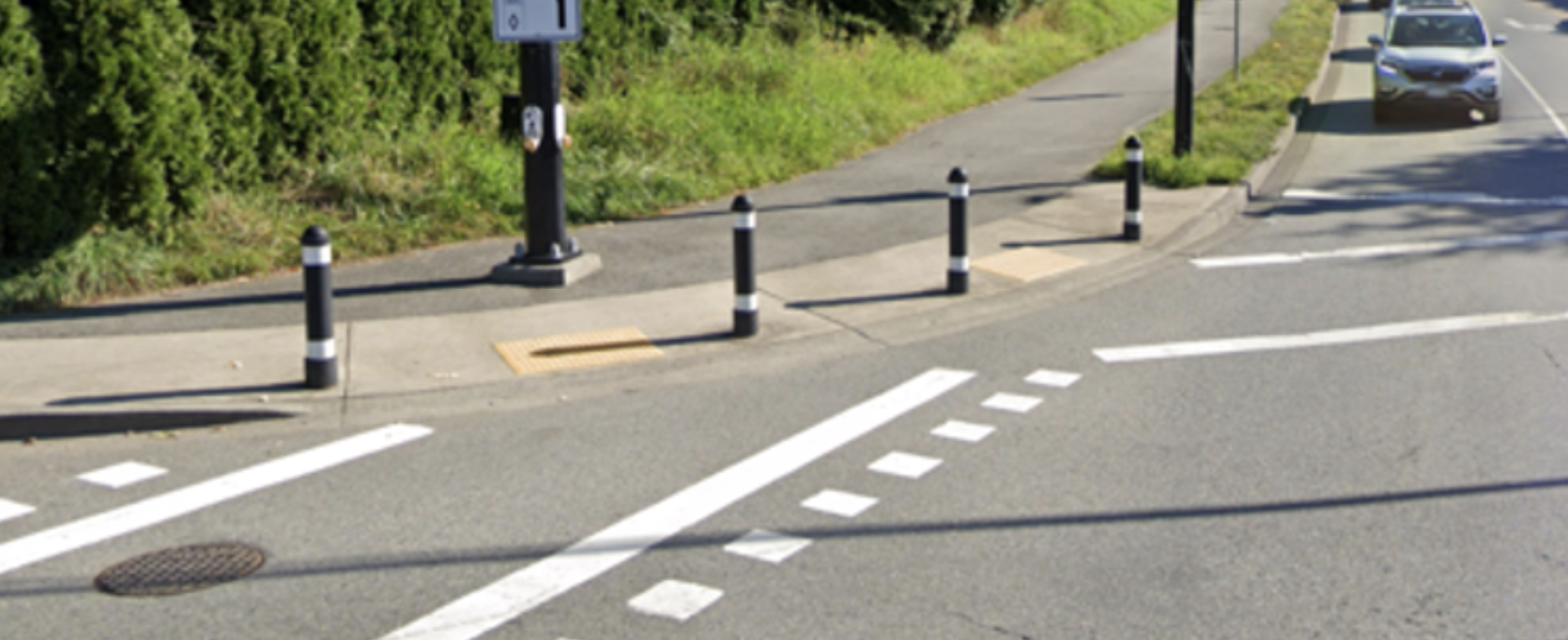
Photo: MUP with narrowly-spaced bollards and a wide turning radius allowing vehicles to turn without slowing. Maple Ridge, BC
Credit: Kay Teschke
Certain shared multi-use pathways can have a higher likelihood of conflict and injury than other path types.4 There are specific circumstances where this is more common:
- Two-way multi-use pathways beside two-way, high-volume arterials with a vehicle speed limit above 50 km/h with multiple intersections and turning movements across the path, such as into and out of driveways.
- Paths with curves, poor sightlines, obstructions, and potential conflict points, including bollards, curbs, street furniture, and light and electrical posts.
- Poorly maintained pathways with potholes, bumps, roots, vegetation, or icy or slippery surfaces.
- High-use areas have many path users moving at different speeds and modes.
Guidelines for the Application of Safe Multi-use Pathways
Limit Placement Alongside Busy Roads
- Two-way multi-use pathways beside arterials signed at 50+ km/h with two-way vehicle traffic and lots of turning movement across the path into and out of driveways should be avoided as much as possible. If absolutely necessary, steps should be taken to improve the safety of path users, including protected intersections, cross-ride markings (elephant’s feet and pavement markings), level crossings, green paint for conflict areas, bend-out crossings, and median refuges.
- Beside busy two-way roads, consider adding pathways on each side of the roadway and limiting people cycling and rolling to travel in the same direction as motor vehicle traffic. People walking can go in either direction. This is a proven means to improve safety and reduce injury.
- Multi-use pathways should ideally be outside of the clear zone to limit the possibility of conflict between people walking, riding or rolling, and people driving.
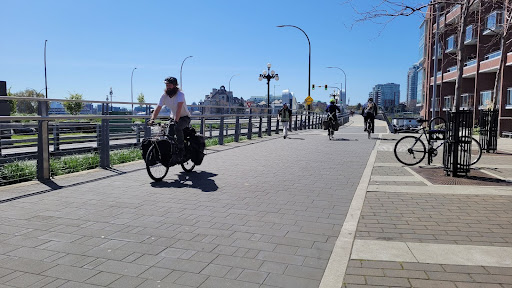
- When justified for critical connections (such as across a bridge or a causeway), multi-use paths within 1.2 metres of a roadway with a posted speed limit greater than 30 km/h should include vertical barriers to minimize potential conflicts with moving vehicles. However, the type of vertical barrier should be carefully chosen to avoid catching cycle handlebars or creating other potential conflicts with users rolling and cycling.
Photo caption to the right: The vertical barrier provides separation for path users. Victoria, BC | Photo Credit: Erin O’Melinn
Add Intersection Treatments
Include high-quality intersection treatments at all major street crossings. This includes creating protected intersections through design elements, including adding queuing areas and making intersections as compact as possible.5 Additional treatments such as bicycle-only light phases, adding cross-ride markings (e.g. elephant’s feet, pavement markings) and conflict zone markings (e.g. green paint) should be added to enhance the safety and comfort for users.
Additional treatments such as bicycle-only light phases, adding cross-ride markings (e.g. elephant’s feet, pavement markings) and conflict zone markings (e.g. green paint) should be added to enhance the safety and comfort for users.
Photo caption to the right: Protected intersection at Quebec St. & 1st Ave. Vancouver, BC | Photo Credit: Erin O’Melinn
- Other potential conflict areas, such as driveways, should include pavement markings, green paint, and cross-ride markings (elephant’s feet).
- Level crossings should also be considered at driveways and roadways to prioritize path users and alert people driving to the presence of the pathway. This is especially important in locations with high vehicle traffic volumes, such as around commercial zones. Coloured and textured pavement can be used to alert path users to the crossing.
- Median refuges should be considered for crossings on busy roads with two-way traffic. Refuges improve safety and allow path users to focus on one direction of traffic at a time. Refuges should be 3.0 meters wide to allow space for non-standard vehicles to wait (e.g. bike and trailer, e-cargo bike).6
- If installing proper crossing treatments is not possible, direct users to an existing safe crossing. Grade-separated crossings can also be considered, but are expensive and must be carefully constructed to ensure user safety.
- Where possible, the pathway should ‘bend out’ from the intersection.7 This allows vehicles to complete the turn and move out of the way of through vehicles while yielding to path users.
Remove Obstacles
Limit, remove, or adjust obstacles in the pathway that could be a collision hazard. Baffle gates should not be used, and rigid bollards should be used sparingly, if at all. When bollards are used, painted lines should be used to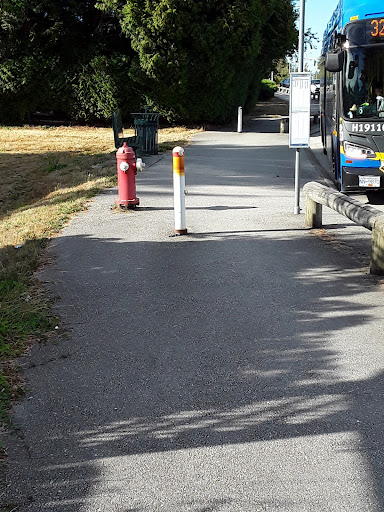 indicate the bollard. See HUB Cycling’s bollard position paper for more information. Street furniture, signposts, and lamp posts should be kept out of the pathway (e.g. in the furnishing zone).
indicate the bollard. See HUB Cycling’s bollard position paper for more information. Street furniture, signposts, and lamp posts should be kept out of the pathway (e.g. in the furnishing zone).
Photo caption to the right: Sign, bollard, and hydrant on the pathway. 168 St MUP | Surrey, BC. Photo credit: John Burgess
- Sharp switchbacks should also be limited as much as possible. These can be difficult to navigate for some users with mobility issues or using longer devices (cargo bikes, bike trailers, recumbent bikes, etc.).
- Regular path maintenance should be included after a path is built to clean up debris, such as leaves, and repair potholes and cracks.
Separate Modes
Consider separating users when there is a higher likelihood of conflict, such as with steep grades when used by people commuting or moving at high speeds or with a higher volume of dogs, kids or elderly users. 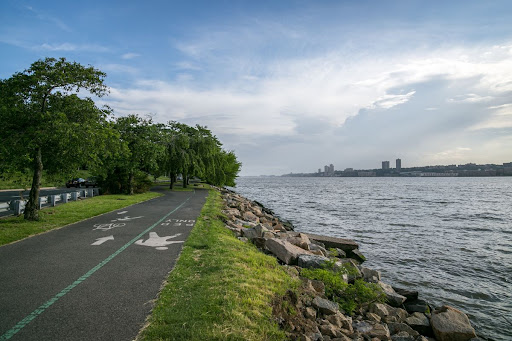
If separate pathways are not possible, there should be visual separation, such as a painted line and symbol markings showing the area for people moving at slower and faster speeds. Directional separation can also be considered in low-volume areas.
Photo caption to the right: Paint Segregation on Hudson River Greenway (NY). Credit: Andriy Prokopenko
- The path should be wide enough to comfortably accommodate the expected volume of users moving at different speeds and passing. A bi-directional pathway should be at least 3.0 meters wide, which allows space for two people walking to be comfortably passed by someone riding and aligns with the Transportation Association of Canada’s recommended lower width. 8
- The volume of users should be considered for separation. Lower-density areas or areas without a lot of active transportation users can be good spots for well-designed shared multi-use pathways. The possibility of expanding the pathway or segregating uses should be considered, especially as user volumes rise. Separating different users is especially important with a high volume of users, as this increases the likelihood of conflict between users moving at different speeds. 9
- Multi-use pathways are not recommended when total peak hour volumes exceed 200 users.
- Speed differences are especially important with the rise of e-mobility devices. A person on an e-bike can be moving six times faster than someone walking (32 km/h vs 5 km/h).
General Guidelines
- Branding and wayfinding should be included along the route, especially at major crossings and decision and confirmation points. TransLink’s wayfinding guidance and sign templates are available for use and are eligible for cost-
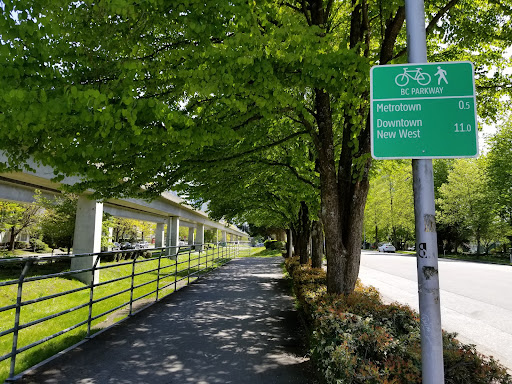 sharing grants.
sharing grants. - Along low-traffic, low-speed roads (e.g. 30 km/h), traffic calming or diversion should be considered instead of a multi-use pathway, with a sidewalk for people moving at a slower pace and a calmed roadway for people cycling and moving faster.
- Avoid switching multi-use pathways from one side of the road to another unless absolutely needed. These switches should be limited to intersections with traffic control.
Photo caption to the right: Wayfinding signs along the BC Parkway | Burnaby, BC. Photo Credit: Ivan C.
Recommendations

Photo: Separated pathway on the seawall in Vancouver, BC. Photo credit: Chris Bruntlett
- As much as possible, design and build separate active transportation facilities to accommodate people moving at slower and faster speeds.
- Limit the number of shared multi-use path projects, especially in busy urban areas.
- Consider multi-use pathways as a recreational option, with separated pathways or protected cycling lanes available as a bypass for people commuting or for faster-moving users.
- Ensure that multi-use path projects that are built adhere to the highest standards of the BC Active Transportation Design Guide.
Learn More
Gavin Davidson leads a workshop on the Design and Operation of Multi-use Pathways
References
1 BC Active Transportation Design Guide, page E5
2 BC Active Transportation Design Guide, page E5
3 Bicycling crash circumstances vary by route type: a cross-sectional analysis
4 Bicycling crash circumstances vary by route type: a cross-sectional analysis
5 Don’t Give Up at the Intersection | NACTO
6 BC Active Transportation Design Guide, page B48. The recommended constrained width is 2.4 meters (pg. G52)
7 Transportation Association of Canada - Geometric Design Guide for Canadian Roads: Chapter 5 - Bicycle Integrated Design. Pg. 55
8 Transportation Association of Canada - Geometric Design Guide for Canadian Roads: Chapter 5 - Bicycle Integrated Design. Pg. 20
